It’s taken me nearly a year to go through the 2,000 odd photographs and videos that Mike and I took. Time well spent.
Looking back over the posts continues to bring back floods of memories.
th-th-th-th-that’s ALL FOLKS!
ɕ
It’s taken me nearly a year to go through the 2,000 odd photographs and videos that Mike and I took. Time well spent.
Looking back over the posts continues to bring back floods of memories.
th-th-th-th-that’s ALL FOLKS!
ɕ
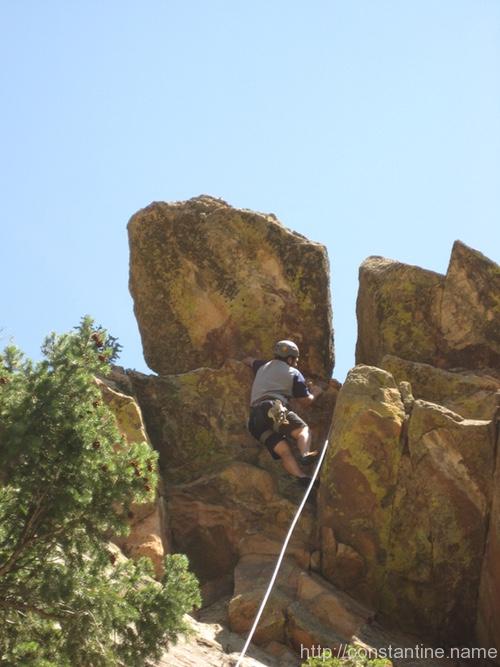
This was the incredible cherry-on-top for this entire Colorado adventure. Hawk-Eagle Ridge is this side, side ravine tucked up behind the Wind Tower just inside the beginning of Eldorado Canyon.
We took this photo (below) on the way out. The tall rock, on the right, closest, is the Wind Tower. So you hike up to the right, between the Wind Tower, and the next mass of rock (on the left in the photo.) Hawk-Eagle Ridge is the crumbly-looking, sloped wall in the middle of the photo. So it’s “the first lefthand ravine” as you go behind the Wind Tower.
…but we didn’t know that going IN. Instead, we didn’t notice this huge, house sized block of rock at the very bottom of the Hawk-Eagle Ridge ravine… it didn’t look like a block that had fallen in the ravine; The ravine was basically not-a-ravine as you hiked past this huge block. So we hike to the SECOND lefthand ravine and busted our *sses slipping our way up this horrid scrabble of avalanching rock, through all sorts of scrub bushes and piles and piles of poison. I expected to step on a snake or three at any moment.
Then we realized we were on TOP of Hawk-Eagle Ridge requiring us to do this sketchy rappel. Or rather, we rigged up a good rappel, and then Mike lowered the gear and rappelled off a couple of (what looked like) ratty old shoe laces. (See the two photos with ropes below.)
The second and third photos below, are the view of the Basile in the main part of Eldorado canyon as we climbed up around ONTO Hawk-Eagle. That’s a road down there at the bottom of the Bastile.
We eventually found a spot of shade at the base of this neat little climb (in the third and fourth photo.) In the second photo, you’re looking back out of Eldorado canyon, so you can get a feel for how we’re just sort of out of sight. The ravine was like hiking back in time. It was clear no one had be up here for decades. This was only the second time in the entire trip that I felt like we were out doing something not normally done. Everywhere else we climbed, it was always well-beaten trails and clearly obvious where to climb; This one was a real adventure. Albeit, a low-height, pretty-near-the-Eldo-access-road adventure.
Here, Mike had scrambled to the top and setup a top-rope anchor. We each took turns scrambling up this neat route. As I’ve said many times, every climb in Colorado had very different rocks. This one was blocky, but the rocks were very natural — normally, oft-climbed routes have their rocks polished pretty smooth and clean to the touch. This rock was very coarse and had a texture that rubbed off on your hands. There was also a very dry moss on a lot of the rock. Overall it was a very different tactile feel. Generally, you get used to your shoes “pasting”, (meaning the flat sole of the shoe has enough friction on plain rock face that you can just stand on very steep faces.) But this rock didn’t paste at all, because there was this every-present layer of fine “dirt” that rubbed off on your shoes (and hands) making everything this unusual sort of dry-slippery. In reality, it was simply the rock naturally weathering, untouched by climbers for who-knows-how-long. (At least, on the routes we climbed.)
Mark — the guy in the white shirt — had opened routes here (aka, “been the first ever to climb”) about 30 years ago. Mike and I spent a lot of time enthralled, listening to stories, and hearing how “these [full-grown] trees weren’t here last time!” I felt it was quite a privilege to get a belay from Mark.
As always, it’s over all-too-soon, and the hike-out commences…
…and I very much like the fact that I get to end my entire series of Colorado posts with a great shot of Mike and Mark!
Cheers gentleman! It was a grand adventure!!
ɕ

A great example of some “roadside cragging”, as they say. You park, hike a short distance and get your climb on!
We got to the parking lot super early and got the rock-star parking space next to the trail. An hour later, the entire area was swarming with fair-weather bicyclists, walkers, joggers… you name it. By then, we were up on the rocks…
The first climb was this neat little two-short-pitch thing. Chilly in the shade, and it led out onto the most dome-like part of the rock. There was this one, long 45 degree sloping crack, on a near vertical face… you could just get enough edge or your shoe in it to caaaaaarefully walk up along the crack. Almost all of the climbing was just sort of trying to “palm” the general features of the rock.
Later, we moved to the left to this sketchy, run-out (long distances of climbing for Mike before he could set gear for protection) monster blocks thing.
Anecdote: A father-son duo that we were talking with, bailed off some gear. (Meaning they gave up on a climb, rappelled and left their gear on the rocks.) So Mike spent about 45 minutes doing this insane down-climb, on slimy wet rocks, just to then wriggle out under this huge roof to pick up some “booty”. (Slang for free gear you find left behind by others.) o_O
Views from the top, looking back down to the road. I think the scariest part of the day was when we walked out, and had to watch the NON-climbers… in sneakers with no gear, dragging their girlfriends up the big blob of rock in the second photo (below). I seriously thought they were going to fall. We hussled up and left because we didn’t want to see it.
ɕ
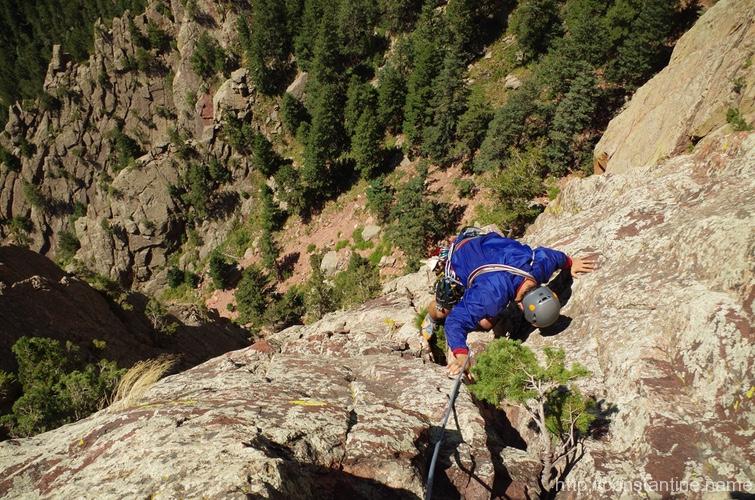
We climbed Red Garden Wall, in Eldorado canyon as a sort of victory lap after we returned from Lumpy Ridge / Estes Park.
The deep notch, in the closest ridge, is the entrance to Eldorado Canyon. Just inside the entrance to the canyon is the tiny town of Eldorado Springs, and a short drive further takes you into the state park.
The approach is a hike up into one of the side ravInes…
At the base of the wall, you make a short access climb up a notch that finishes as a short chimney. There were two climbers in front of us, so there are a couple shots of another climber going before us…
From there we walked along an interior sort of cleft — with the wall on both sides of you. There were climbable routes all over once you ascended the access climb. We picked a 2 pitch route that had a huge variety of rock and features. Crumbly parts where everything was loose, smooth almost slab areas, and huge angular blocks near the top. Pine trees right in the climbing lines, wild flowers, moss. This climb had everything, including a really old — not dead yet! — gnarly tree as a belay-station anchor…

At the summit, we were atop a tremendous tower! The views to the east showed Boulder and Denver just visible. And there was some debate about how exactly we were to get off this thing…
Eventually we figured out the exit; A short rappel, a walk down around the tower to the other side, and then a spectacular rappel out of this enormous notch…
ɕ
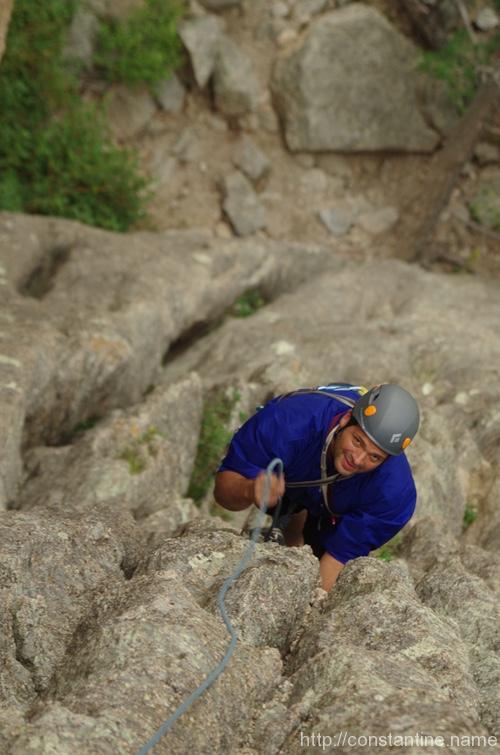
We picked Organ Pipes to be our last climb on Lumpy Ridge. This was our last day in Estes Park Colorado. We had been camping just inside the Rocky Mountain National Park at the Aspen Glen campground and it was a short drive to the Lumpy Ridge parking area.
As we approached the parking area, the Twin Owls are impossible to miss. They look exactly like two roosting owls. Below them, just in front of them, is a light colored triangle of rock. It actually took us a bit of hiking around to find our climb. But as we drove away, we realized Organ Pipes is tucked in the shadow, just to the left of the big triangle of light-colored rock. When we reached the top of the climb, we were at the base of the Owls.

Above is the view looking up Organ Pipes — it literally looks like organ pipes. Some of the undulations are easily grabbed by hand, some are large enough for you to stand in, or to work up them like a miniature chimney. It’s about 20 feet wide and runs up about 150 feet. Near the top, the rock changes colors from this dark grey, to a lighter color, and it just happened to change colors where the shadow fell. So there’s a ledge at the top of the grey, where Mike eventually set up a belay station and snapped about 300 photographs.
The video above gives you a quick tour of where the climb is situated.
Above is a small selection of the many spectacular photos Mike took. Throughout our trip, he was learning to use his camera and this climb was the culmination of him getting to try everything since the climb was pretty easy, with a short pitch where we could easily see each other and communicate.
The vertigo-inducing video above makes the climb seem steeper than it really was. The further we climbed, the steeper it was, but it was “only” vertical at the top — it doesn’t overhang or lean out at all. You can begin to hear that it’s getting windier…
This isn’t a “bolted” climb; Meaning there are no bolts in the rocks for easily climbing in fall protection. As Mike climbed first, he placed “protection” into the rocks. As I climbed up second, I had to stop and “clean” all the gear. The video above gives you a glimpse of how you spend a lot of time when you are “the second.” Pausing — hopefully in a spot where I only need one hand to hang on — while carefully disassembling “trad gear”. (“trad” is short for “traditional”.)
Three more shots of me just about to top-out on the first pitch. By this point, Mike and I are only a few feet apart and he’s bored out of his mind from sitting in his harness watching me climb.
Above is just a few moves from the very end of the first section of the climb. All the junk over my shoulders, and hanging from my harness is all stuff I’ve “cleaned” along the way. At the belay station, I’ll pass all that stuff back to Mike. If this was a long (that is, “multi[ple] pitch”) climb, he’d start off again, and we’d repeat the climb/clean/pass-gear cycle over and over.
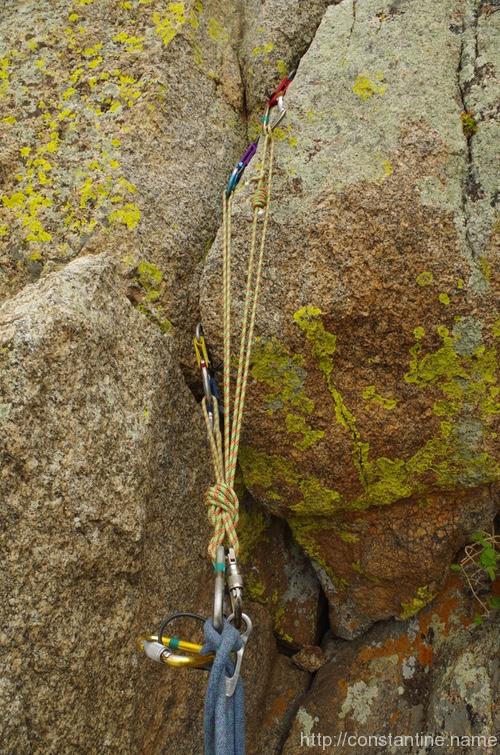
Above is a beautiful shot of a textbook belay anchor. Mike has four pieces of gear in the crack (the lowest one is pretty well hidden from view.) They’re slung together in a very particular way using a special rope (called a “cordelette”) with a very particular arrangement of knots. At the belay point, the arriving “second” would tie in, and pass his cordelette to the lead climber. (So the lead climber has a cordelette to build the next belay station.)
For this climb, the second pitch is very short. Mike could easily have climbed all the way to the top. But by stopping at the ledge, he had a great view of my climb so he could practice with his camera. This final section of rock pitched up to just the slightest overhang, and was perfectly smooth. Took me at least 15 minutes to climb 10 feet using the crack in the rock and side wall.
At the top, catching my breath at the foot of the owls. From here it was a “walk off” down the angled “roosting ramp” to a foot trail and a stroll back to the van.
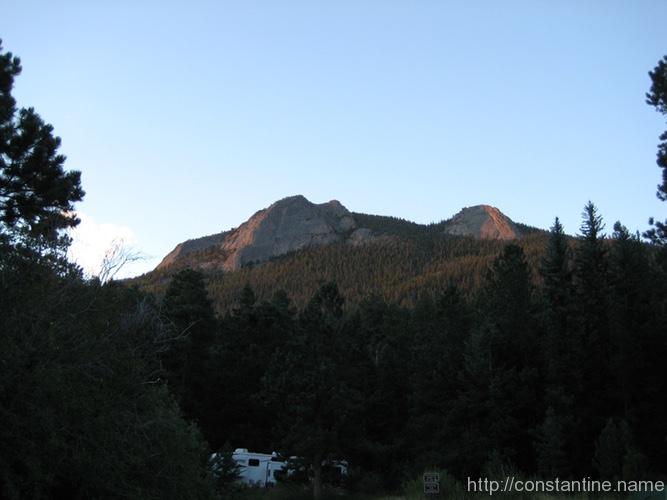
Back at our camp site, we took one last look at Deer Ridge already talking about coming back to have another go at climbing it. We packed up our camp site and headed south, back to Boulder.
Goodbye Estes Park and Lumpy Ridge!
ɕ

Batman and Robin is a neat climb on Lumpy Ridge in Estes Park!
Mike and I picked this climb after spending the entire morning trying to climb Deer Ridge. So here we are, roasted, before we even hike in to Batman and Robin.
Lumpy Ridge has a slew of easily accessible climbs. It’s a stroll in the park — literally — to reach the climbs. The only confusion was the guide book said “readily visible from the parking lot.” We wasted some time until we realized they meant from the original parking lot, not the recently constructed one (which is very much easier to access.) Anyway. Last photo above is the view of the old parking area, from near the base of the climb.
Above are some views from the base of the climb. As you can see in the panorama, the weather was a little “snotty” (as we sailors would say) — cool, gusty winds from changing directions, spritz of water now and then. The climb — in the third photo — reminded me of the original TV show when Batman and Robin would lean forward and they turn the camera to make a really bad “scaling a wall” shot. We could have walked up it like that with a rope, but it was still fun. In the middle of the climb (no photos sorry), there was this cool section with huge angular blocks, so you were trying to paste yourself like a gecko on these huge flat, sloped surfaces. It was really unique. (Honestly, every climb in Lump was really unique and different.)
We reached the top of the climb very late in the afternoon. The last 20 feet was this crazy-fun, who-put-this-here?!, section with big blobs of rock going straight up. There was plenty to hold on to and climb, but you really had to be fiddly, working to get every inch without peeling off the rock. (Which makes for very fun climbing.) At the top… surprise storm! The wind picked up and a thunderstorm was rolling in over the ridge from behind us. On the top of rock is a Bad Place To Be(tm) in a thunderstorm. So I rappelled off our belay anchor, Mike stripped it down and did a free (no gear) down-climb of about 15 feet as we scurried for cover. Once off the tippy-top, we rappelled 3 sections (Like Batman and Robin!) and ran — LITERALLY RAN, more than a mile out of the park with our gear to beat nightfall. We got to the van just after dark, completely exhausted and soaked in sweat.
We had a total blast! :*D
ɕ
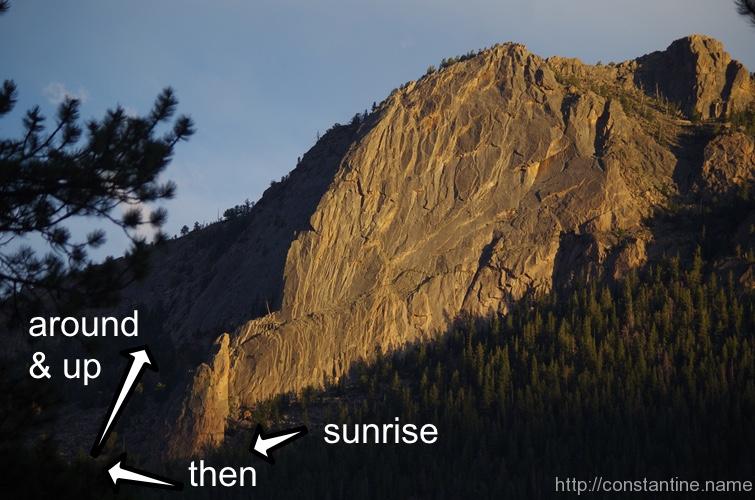
Epic: This was meant to be the first climb as part of our 24 hour challenge. A classic bush-wack approach to the base of the rocks at sunrise. Then 5 pitches of traditional climbing finishing at the overlook on top of the mountain.
We got up at 4:30am, having packed everything the night before. It was pretty chilly and we were facing a good hour-and-a-half stomp through the woods. Our plan? …walk straight through the campgrounds — literally through camp sites and out the back of the campground. Then, head directly up hill until twilight brought us a good view of the mountain.
Initially, we were walking through grass-carpeted woods, and through a small meadow atop a little hill. But the further we went, the steeper it got. Until it turned into a true “class 3” scramble.
Twilight was upon us as we reached the base of the lowest spire.

We reached the base of the rocks moment before dawn.
…and this is what the dawn “Alpine glow” looks like at 8,000 feet on Deer Mountain.
Giddy as school children — and possibly a wee bit oxygen deprived — we took a break to sight-see.
The final approach phase — yes, this is all just to get TO the climbing — is to duck around the lowest spire and climb up another 500 feet. To the left of the nose is a gently sloping shoulder called Stagway.
We totally loved that the “Notice” sign, had been there so long, that the actual notice was gone. The view from Stagway was beyond awesome, and was well worth the two hours of extreme labor to reach it’s ~8,500′ above sea level view point.
At this point, we could finally walk up to the base of the climb and assess. We were facing 30+ mph wind gusts, storm/rain clouds coming down the valley, and the first section was 80 vertical feet of crack climbing. (ie, there are no hand holds on the rock, just a crack to wedge your fingers and hands into.) We discussed it for a while, and I eventually called it off. It was just too many things weighing on the wrong side of the equation.
We snacked and discussed climbing the random looking stuff directly above Stagway. Unfortunately, the climbing guide said all the climbable lines were on the nose and to the right. On the plus side, it would be easier (in terms of technical difficulty) than climbing the nose, and just for a perk, it would be opening a new line. (Meaning no one had ever climbed it.) We figure that after one section through this stuff on the left, we could traverse back to the right, and continue up the nose’s progressively easier sections.
Unfortunately, this is also where we stopped taking photos and video as things went from being “fun”, to being “hard work.”
We setup and started up through the randomness above Stagway. After a long, long time slowly feeding rope to Mike, he stopped climbing and setup a belay point totally out of my sight. (Remember, it’s windy so we can’t communicate at all beyond a very simple rope-pulling system.) Eventually, I started up after him. I won’t say it was a mistake, because it was still fun at parts. But we spent nearly two hours, gaining about 50 vertical feet. I seriously thought Mike had been trying to write his name on the wall as I followed the rope up and down (down?!) left to right across the rocks. There was a lot of tricky climbing, and a tremendous amount of effort for almost no vertical gain.
Finally, at our first belay, with only half the gain we needed to go around the nose’s first section, we both decided to bail off. Bailing from the middle of a mountain requires leaving gear behind; You have to build an anchor, and then rappel from that anchor. You can pull your rope down, but the gear has to be left behind. Part of our plan for the 24 hour challenge included “bail gear”. That’s a small collection of things that we wouldn’t normally use, because if you used it, then you couldn’t bail off it in a pinch. This was litterly one nut, and a carabiner that Mike had found in the Himalayas that had been left behind when someone else had bailed.
It took us 10 seconds to rappel off of our two hours of work. That was followed by an hour of down-scrabble all the way back to our camp site, where we collapsed pretty exhausted. At this point the weather seemed to be deteriorating, and we threw in the towel on our entire 24-hour challenge. We never even tried to cross over to MacGregor slab. We did say, half-jokingly, that we would come back some day and get it right.
Aside: as I write, in March 2015, we are planning to return in July.
On the other hand, we both felt like climbing more, so we headed over to climb “Batman and Robin” over on Lumpy Ridge. (Which will be my next post.)
ɕ
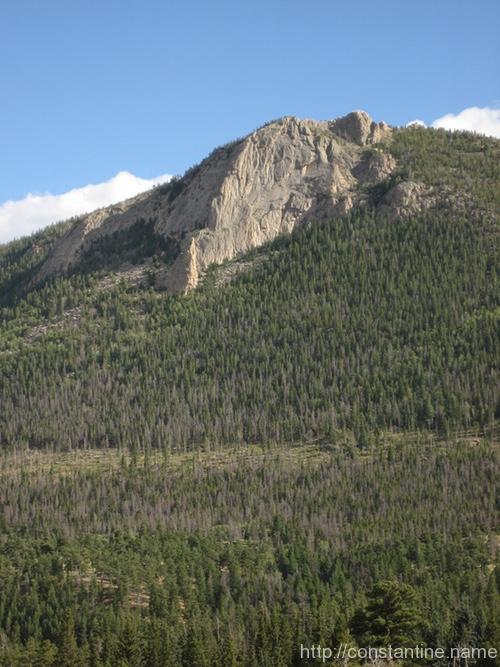
Mike and I were planning a 24 hour climbing challenge; Basically, an attempt to keep moving (hiking from one climb to the next) and climbing for 24 hours straight.
These photos are from way back in July 2014 when I was rock climbing in Colorado with Mike Bowyer. I’m only just now getting back to going through the rest of my photographs.
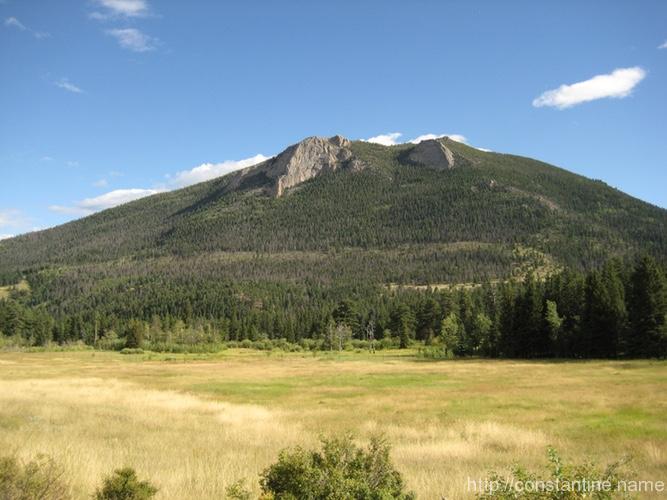
Aspen Glenn campground — where we were camping — is tucked into the trees at the base of this mountain.
Our plan was to get up before dawn (4:30 to be exact), hike the 1,500 vertical feet through the forrest (starting at about 7,000 feet above sea level mind you.) There’s no trail to the base of the climb; The plan is to just go straight from our campsite to the climb, and arrive at the base of the climb at dawn — a test of our planning and navigation in the dark. Climb the nose — that prominent line between the sunny and shady faces of the big beautiful hunk of rock. Then hike down (there’s a trail from the top that curves around the right shoulder) and back through our campsite for water and food.

At the campsite, we’d pick up a pre-stuffed extra gear bag and hike across the valley floor. On the north side of the valley is MacGregor slab; It’s just this big ‘ol gently sloped blob of granite with about 12 different climbable lines. We planned to stash our gear bag at the base of the slab, and then start doing laps of: climb-up, and walk-off around the shoulder, all day and night. Again, there are no trails that lead to the climbing on MacGregor. It’s just a bush-wack “that way”. If everything went perfect, we hoped to get the last climb to end on the top of the slab at the next sunrise.
As the sun set on our day of planning, I set up my camera to take a long, time-lapse of the first thing we planned to climb the next day. This isn’t a “fade to black” at the end, it’s a “sun went down, it got pitch dark” end. (6 seconds of video.)
ɕ
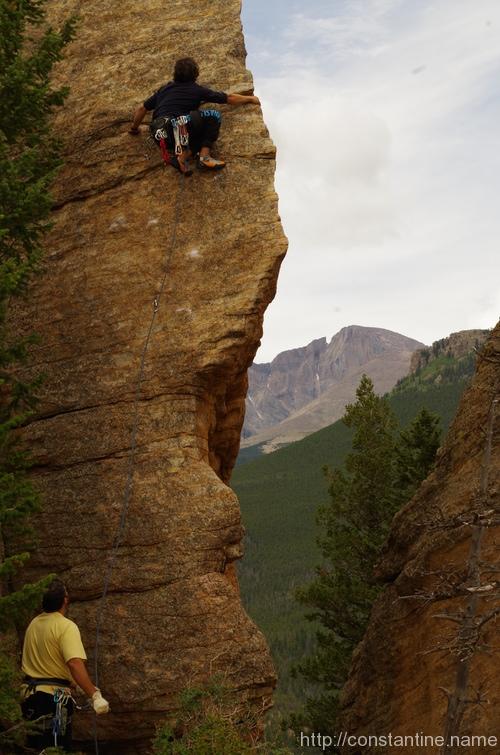
Out of about 2,000 photos that Mike and I took, I think this is the only one that shows both of us. Here are a few more non-climbing shots showing just how incredibly awesome the scenery is.
Ok, well, one more climbing photo. I’m sorry, but this photo is just off-the-charts awesome.

When you park at Lily Lake, the first thing you see is this hillside that looks like Godzilla. We arrived before the sun was fully shining into the valley, and it was eerily quiet. it’s the perfect first-look when you’re about to hike into something called “Jurassic Park”.
Just to the east(left) of the epic “Edge of Time” route, lies “East of Eden”. I had given up on the hardest part of Edge of Time, very near the bottom, and so I shuffled over to East of Eden. From East of Eden I climbed up above the crux and worked my way back over to finish out the Edge of Time.

True story bro’: I started up one of the trees at the base of East of Eden for about 8 feet, and one of the guys we were climbing with goes, “Craig, I love your attitude!” (Because I refused to give up on getting to the top of the Edge of Time.) Halfway up the tree I shouted back, “up is UP!” …all of which I thought was hysterical, because if you know me well, you know that generally you’d say I have a “bad attitude.” What can I say, Colorado brings out your best!
words words words photos words words Awesome words words Spectacular words words ‘Nuf said.
ɕ

There’s a great roadside, sport climbing area across the street from Mary’s Lake in Estes Park.
On the Monday that we arrived in Estes Park, we stopped at the local gear shop, and then went here to do some climbing. These are just a couple more beautiful photos that Mike took while we were hanging out.
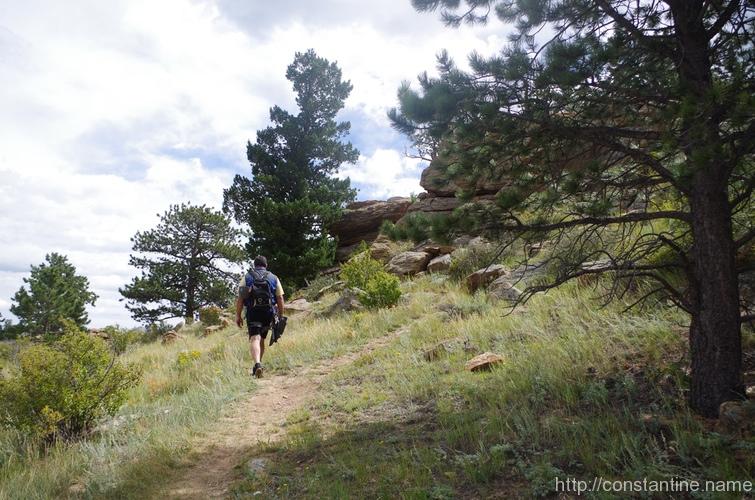
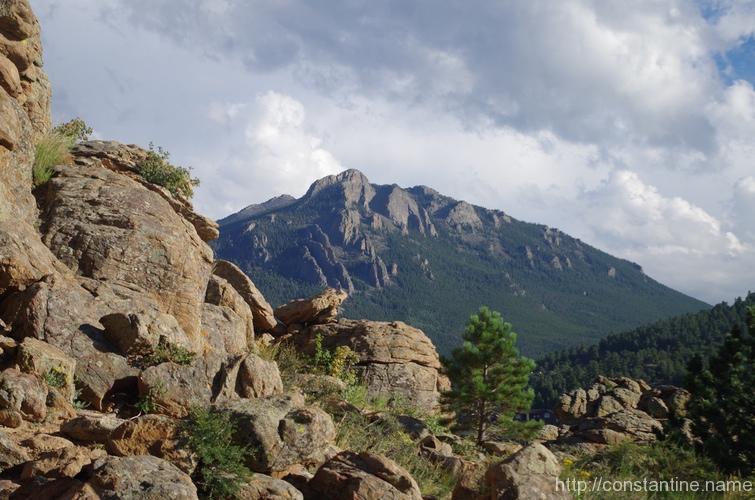
ɕ

A few more photos from our drive up/into Estes Park Colorado.
We rolled past this spectacular peak just after coming up out of the canyon on Route 7. It’s not a volcano, there’s just a perpetually forming cloud stuck to the shoulder as the wind blows steadily from the left.
Route 7 also rolls past Long’s Peak, which has the world-class climbing feature called “The Diamond” (the slightly darker, diamond shaped area of rock on the right.) But whichever way you swivel your head, the views are majestic!
This last shot is of Mike, who ran out of the van and jumped upon the bridge railing as we were driving down the access road to our campsite in RMNP. It turns out, this beautiful hunk of granite is McGregor slab. We had intended to climb its very accessible 5.7-8 routes, but that’s another story.
ɕ

On August 23rd, I took a drive up Flagstaff Road. Spectacular views! Here’s a few more photos I selected as I’ve been filing photography.
ɕ

Our climb of the third Flatiron was leisurely enough that we took a lot of photographs. As I’ve been going through them, I’ve carved out a second set of must-see shots.
(There’s also my first Flatiron 3 post about the best beginner climb in the solar system.)
The Flatirons are just smack-dab right next to Boulder. Everywhere you go, the “front range” is just looming to the West. Sitting at Einstein Bro’s Bagels, the slabs of rock beckon tantalizingly close. Flatiron 3 is striking because the backside is exposed too, making the tip of the climb into an impressive prominence. (…and it makes for a wickedly fun, triple-rappel off the back too!)
The approach is simply a beautiful, long, hiking trail. (Or as we took to joking, a trail for the “walkers.”) The lower parts of the trail are heavily trafficked, but the further you go, the more interesting the terrain gets. Eventually, Flatiron 3 starts peeking at you through the trees.
A few shots from the top… just taking in the view!
At the very top, there’s a comfy recess just behind the true summit. Mike got excited at the huge slab with the prominent crack system that is hidden behind the Flatiron. (If he’d had his way, we’d have trekked over there immediately after rappelling off the thing.) There’s also a commemorative plaque set in the rock. Beyond the plaque lie the Rocky Mountains!
After you rappel, you “walk off” down a steep ravine filled with scree, between the 3rd and 2nd Flatirons. If you look closely in the first two photos, you can see “hikers” (or perhaps climbers walking off) on the rock to give you a feel for the scale.
ɕ

We were in Eldorado Canyon on three separate days. These photos are from Wednesday the 20th, when we went in to climb the Wind Ridge route on the Wind Tower. As you approach Eldorado Canyon, you’re driving into the “front range”. You leave the Flatirons to your right, and wind your way into the canyon.
Once you get inside the Eldorado Canyon State Park, there’s world class climbing just jammed everywhere. Just inside the park is a foot bridge that leads to the south side climbing, and the Bastile is just a few paces up the road.
Climbers are always on the Bastile. At the bottom, they’re basically standing in the [dirt] road. But, you can see them from various other places in Eldo. Here, I took a pause climbing to get the camera out and snapped these photos across the canyon.
From the Wind Tower you get a better sense of the size and layout of the canyon. This first photo is taken while walking off after the climb. So we’re descending and heading back towards the creek and road. The second photo is from the very top of the Wind Tower, looking across the canyon (the road and creek, in the bottom of the canyon, are not visible.)
Finally, some views of the Wind Tower itself. As you enter the canyon, it is on the right — the lighter colored mass. The slightly darker rock, on the left, is another feature, with a trail snaking up between them into a high ravine. To get a sense of the scale, note the huge flake of stone that has slid off the tower.
ɕ
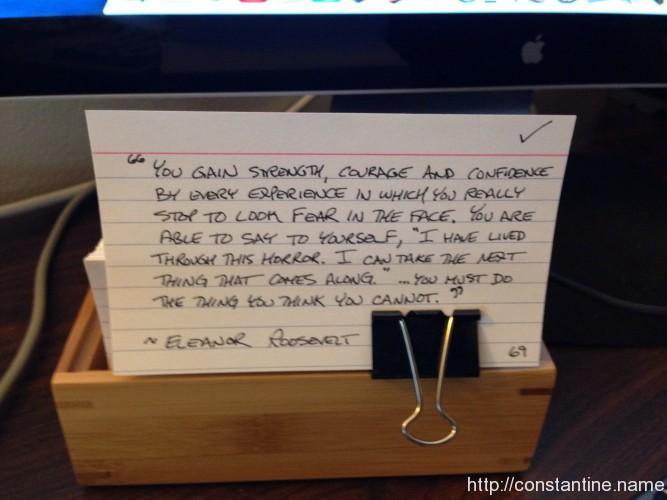
I left this quote on my desk when I left for Colorado. …and what a challenge it was!
ɕ

In Jurassic Park there’s a route called The Edge of Time (5.9R ***) which is on the cover of the guide book.
Simply an unbelievable piece of rock carved into a literal prow.
My attmept was sketchy. I spent a while projecting the 5.9 crux (which is way above my climbing grade.) Eventually, I punted and move left to East of Eden (5.9 *) and worked my way up, and then back over to finish the arete. (Sadly, no photos of me un the upper part of the Edge.)
Mike’s run up was a straight shot as he put up the top rope for the rest of us.
ɕ
When you’ve had a ton of fun, and it’s still fun to pack to go home!
ɕ

A short walk up from Lily Lake is a hidden ravene with sport climbing routes galore. (There are bolts drilled into the rock making it easy to clip in for protection.)
The first rock on the left is, well, “Left Hand Rock” and is home to Dark Days (5.8), which simply runs straight up a seamingly featureless curved slope. The next rock up is Dinosaur’s Foot, with the aptly named Index Toe (5.8) and Middle Toe (5.9—).
ɕ
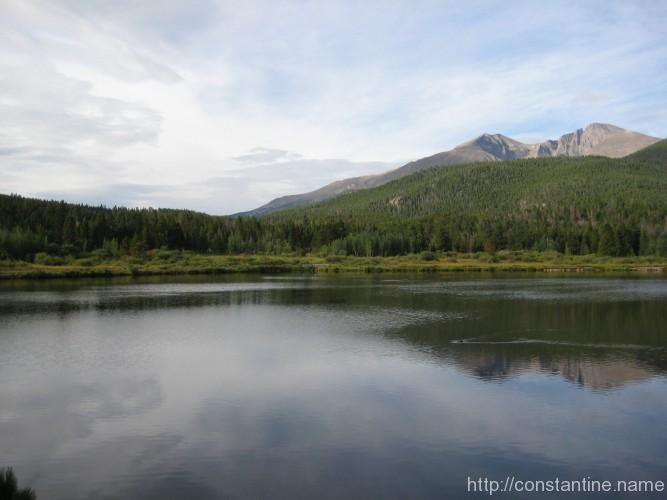
To get to the “Jurassic Park” climbing,area, we parked at Lily Lake. Spectacular walk around the lake to get to the climbing approach.
ɕ
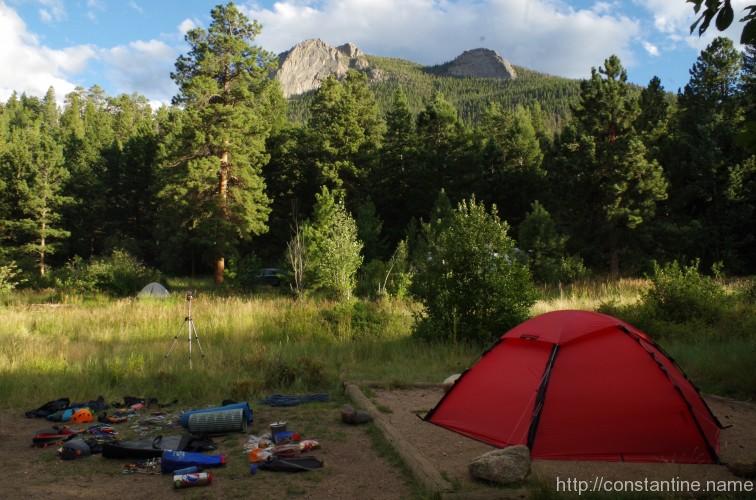
It’s been many years since I was camping, but this campground was superlative.
ɕ